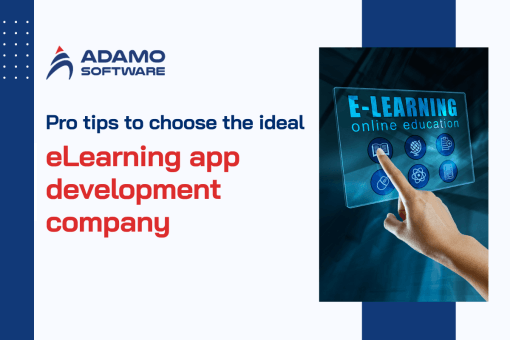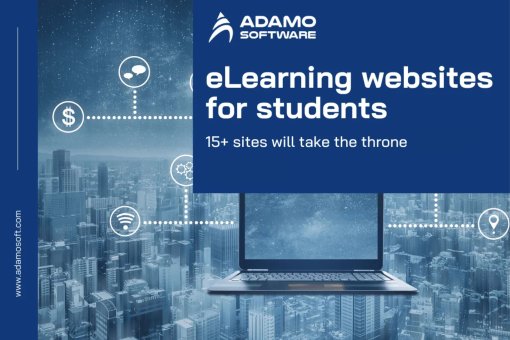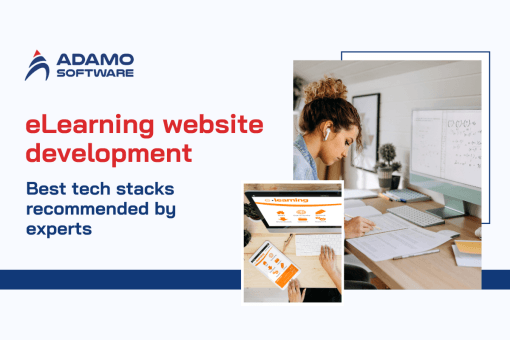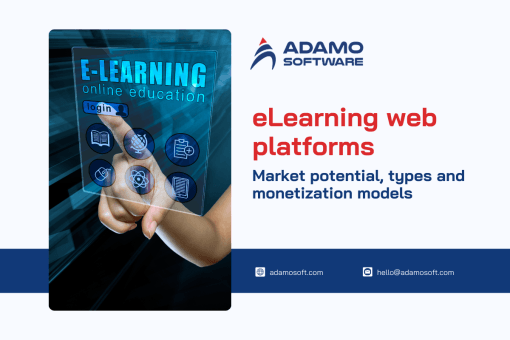Social learning platform: Key features, how to build and emerging trends to consider

In the digital age, social learning platforms have emerged and reshaped how we acquire knowledge. These platforms leverage the power of technology and community to enhance learning through interaction and shared experiences. As the demand for more interactive and accessible learning methods increases, the opportunity to create a successful social learning platform becomes easier.
According to the Global Education Market 2023 report, the online learning platform market is expected to grow by 28% annually. It could reach an estimated value of $66.7 billion by 2028. This growth underscores the growing shift to digital education solutions.
This article will provide the basic features of social learning platforms, how to build them, and the potential they hold for the future of learning. Are you thinking about building your social learning platform? Keep reading!
I. Basic features of some best social learning platforms
What makes social learning platforms so popular? At the core of these learning platforms are social media-like functions. They enhance learning by facilitating communication, sharing, and collaboration. In this section, we will explore the basic features of some of the best social learning platforms:
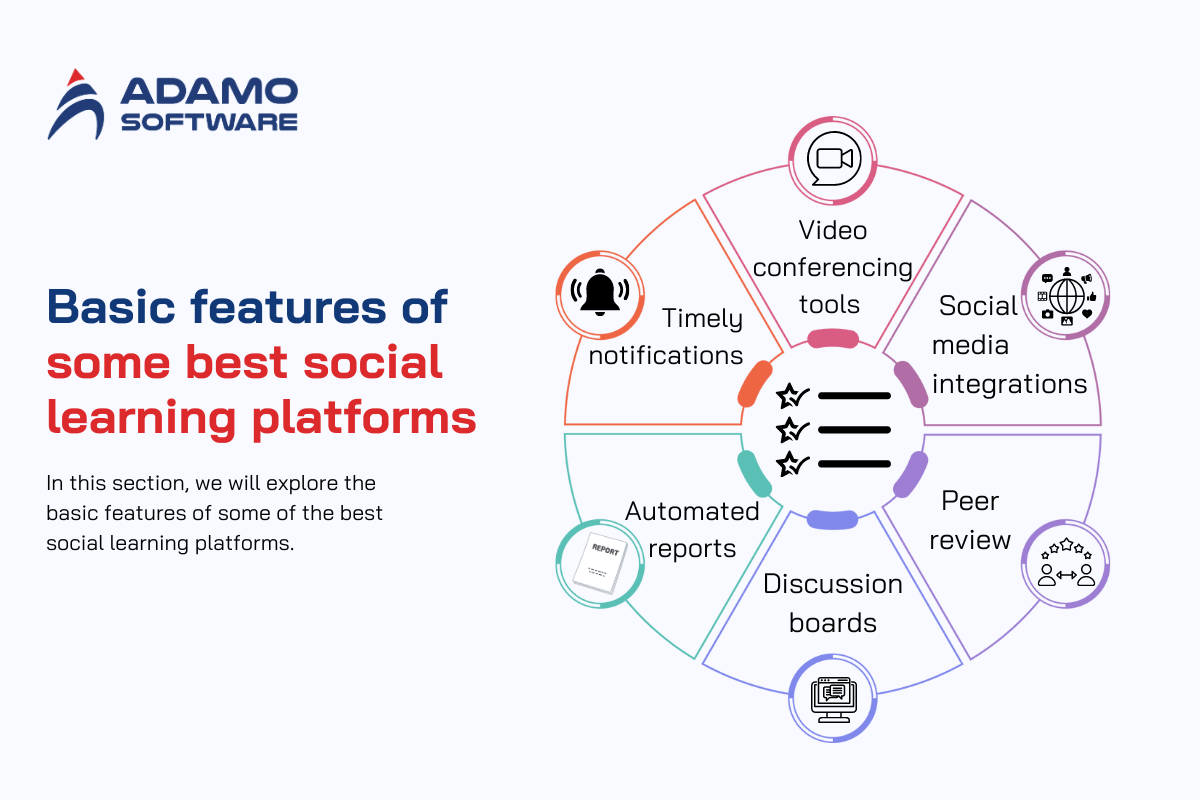
1. Peer review
This key feature sets social media learning platform apart from traditional LMSs. Peer assessment allows students to provide feedback to their peers within the platform. It can be pre-set and automated by instructors, saving them the time of manual learning. Finally, peer assessment increases interaction, engagement, and a sense of community among students.
2. Discussion boards
Social learning is learning with others. Platforms designed for real social learning experiences incorporate discussion forums or online communities that allow students to interact with each other. In other words, having discussion forums within an LMS brings the concept of social media to smaller, more private groups of people learning together.
3. Social media integrations
One of the basic features of social learning platforms is integration with social media. However, social media platforms were once considered a distraction from learning. Now, modern learning places have taken advantage of their benefits.
Social learning platforms allow students to connect their learning accounts with social media platforms to share their achievements and learning milestones. In addition, learners can also share their knowledge and experiences, which helps build a positive community.
4. Video conferencing tools
In addition to watching recorded video lectures, students can actively participate in online lessons with the video conferencing feature. The video conferencing tool allows students to observe the instructor or participate in discussions with their classmates. Teachers can also organize live Q&A sessions so students can understand the lesson better. This feature is essential for distance learning and makes it more exciting and engaging.
5. Timely notifications
Instant notifications are one of the essential features of a social learning platform. This feature helps learners stay updated with important assignments and announcements quickly. They help students stay on track with their learning goals by reminding them when something needs your attention. Additionally, learners can participate in discussions and respond to new content as soon as it becomes available. This feature ensures that learners get all the essential content from their teachers.
6. Automated reports
Automated Reporting is a crucial feature of any online training software. It allows L&D teams to review analytics, read reports, and present them in an easy-to-understand format. Reports can show which social learning modes are yielding the best results. They can also identify areas of weakness and even suggest ways to improve them. Reports can be as basic as completion rates and online course duration or as complex as heat maps and attention spans. By noticing when learners’ attention spans are waning during a video conference, instructors can adjust their delivery mode next time.
Also read: What is a social learning platform? Benefits and top examples classified
II. How to develop an ideal social learning platform
Building a successful social learning platform that engages users is a challenging task. Outsourcing your software development team can help your business ensure the success of your solution. However, there are also some steps you can take yourself.
Here are the steps to developing an ideal social learning platform:

1. Identify the target audience – Engage with potential users
Before developing a social learning platform, you need to consider what your users need. Understanding your users’ specific needs, interests, and characteristics can also significantly influence your platform’s structure, content, and features. So, conduct insight research on the people in your community.
Here’s how to analyze and understand your users’ needs through demographic and psychographic profiling:
Step 1. Conduct market research: To conduct market research, you can conduct surveys and interviews with users. These potential users can be educators, students, professionals, and anyone interested in continuing education. Market research helps you understand your target audience’s characteristics, needs, and behaviors.
Step 2. Audience segmentation: The next step is to divide your target audience into segments based on age, education, occupation, or other relevant demographic information. Segmenting your audience allows you to tailor your social learning platform to each group’s specific characteristics and needs.
Step 3. Analyze learning behaviors: Once you have segmented your audience, you must analyze their learning behaviors. For example, a younger audience may prefer interactive and visually appealing content. Conversely, professionals may be looking for more in-depth material in text form.
Step 4. Determine your technology level: You should assess your target audience’s technology skills to determine the level of complexity of your platform’s interface. Younger or more tech-savvy groups may benefit from advanced features. Conversely, older or less tech-savvy groups may require a more straightforward, user-friendly, and easier-to-navigate design.
Step 5. Assess learning motivation: The final step is to explore the motivations that drive each learning segment. Some learners may seek career advancement, while others may seek to improve their skills in school and work.
2. Begin with an MVP
Starting with an MVP allows you to test your product on a smaller scale and improve your platform before fully launching it to users. This feedback will help you find and fix bugs and give you the best chance of success. Plus, the first group of users will create an activity on your platform, so you don’t have to start from scratch.
3. Creating fresh content
While a platform with many resources is excellent, it can quickly become boring without new and engaging content. Who will pay attention to boring text-based learning materials or training videos when there’s so much multimedia and short information out there? That’s why uploading new content regularly, such as videos, audio clips, images, and infographics, is so important.
Your social learning platform should encourage user-generated content like community blogs or forums. Learners love to learn from their peers, so the more user-generated content you add, the better. However, don’t forget gamification features and interactive elements to keep people engaged in learning.
4. Encourage involvement
Social learning would only be social with collaboration. So, for your platform to be successful, you may need a strategy to incentivize people to use it. You can devise ideas to incentivize user engagement through exclusive content, digital certificates, discounts, etc.
5. Marketing
Building a community is just the beginning. It would help if you had a good marketing strategy for your platform. This includes email marketing, social media advertising, SEO optimization, and content marketing. If your platform targets a specific subset of users, consider using direct email with your users.
6. Evaluate the platform’s success
Knowing how it is doing is the final key to developing a successful social media learning platform. How can you be sure that your efforts are paying off if you don’t measure the effectiveness of your platform? So, metrics will be an essential aspect of this. Make sure you always choose the right metrics according to your goals.
The participation rate, engagement level, and user rating will help you know whether they like your platform. Remember to ask for feedback and ratings regularly. A simple way to collect user reviews is to have pop-up messages on your learning platform asking for their ratings. Additionally, you can run surveys to gather user opinions. You will know what needs to be improved to develop better in the future.
III. Technical considerations for expanding social learning software
Ensuring the scalability and sustainability of your social learning platform is critical. It is essential for the long-term success and growth of your platform. Therefore, you should consider carefully planning your technical architecture and business strategy.
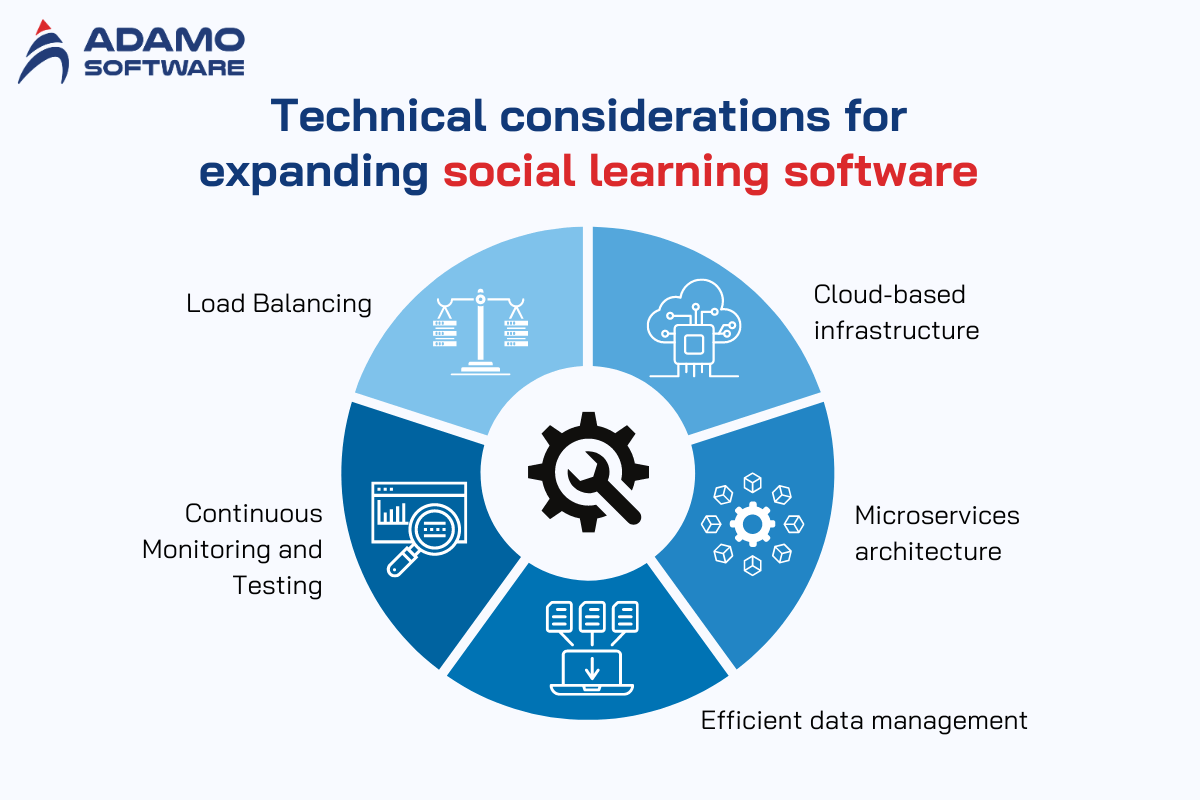
Here are the technical considerations for a social learning platform to achieve scalability and sustainability:
Cloud-based infrastructure: An essential factor to consider is the cloud-based solution. This factor makes the social learning platform sustainable and easy to scale. A cloud-based infrastructure automatically scales resources according to demand, ensuring secure and efficient data management.
Microservices architecture: Implementing a microservices architecture is an essential factor to consider for your social learning platform. It is a software design approach where an application is built as a collection of small, independent services. Each service is responsible for a specific function. Therefore, implementing a microservices architecture makes the platform more flexible and easier to manage.
Efficient data management: Optimizing data storage and retrieval processes to handle increased load is another consideration. Use horizontally scalable database solutions and implement efficient data caching to speed up processing and reduce latency.
Load Balancing: You should use a load balancer to distribute user requests across multiple servers. It ensures no single server is overloaded and helps maintain performance during peak usage times.
Continuous Monitoring and Testing: The last thing you should consider is constant monitoring and testing. You should regularly monitor the performance of your platform and conduct load testing to identify potential bottlenecks before they impact your users. This proactive approach allows you to make the necessary adjustments promptly.
IV. Social learning trends to keep an eye of in the future
As we look to the future, the potential of social learning to transform professional development is extraordinary. Adopting this dynamic form of learning will become a strategic turning point for organizations that want to develop a continuous improvement and innovation culture.
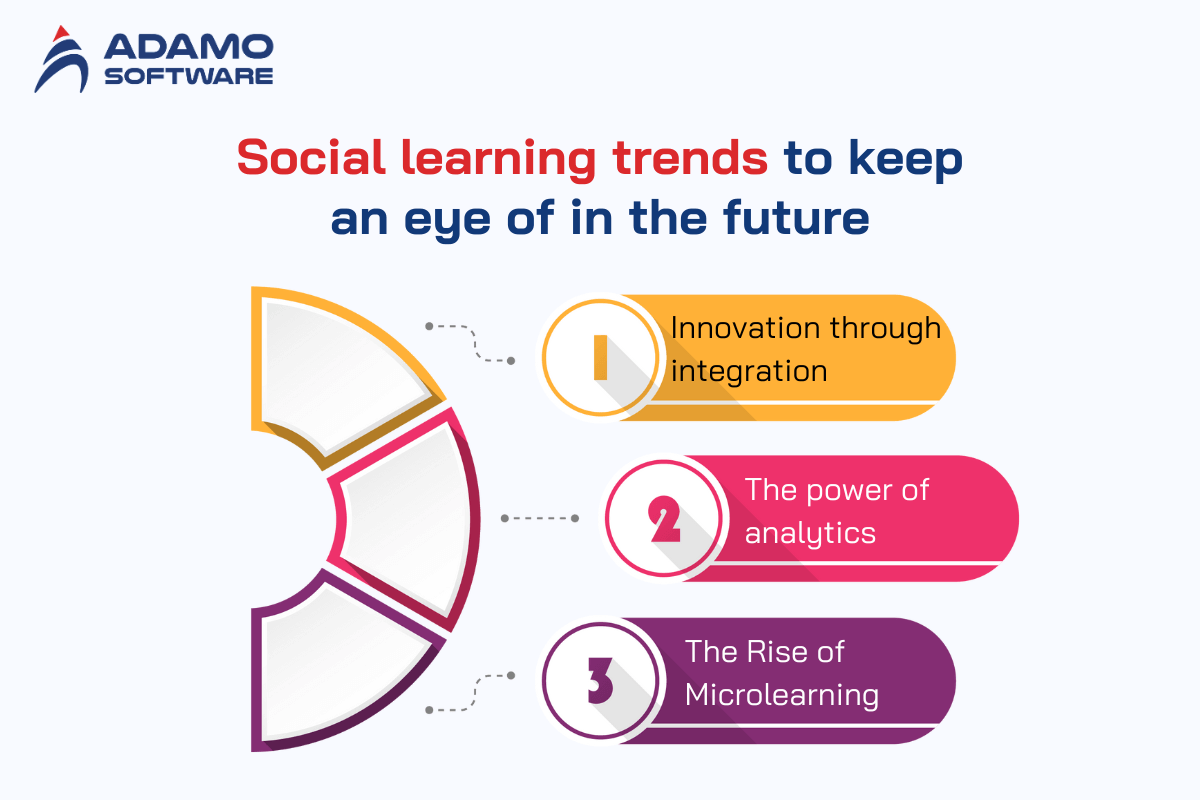
1. Innovation through integration
Integrating advanced technologies such as Artificial Intelligence and Machine Learning into social learning environments promises to deliver new experiences to customers in unprecedented ways. These intelligent systems will recommend personalized content by analyzing individual learning patterns and driving tailored learning journeys.
2. The power of analytics
Advanced analytics will revolutionize the way we measure the impact of social learning. By quantifying contributions and their impact on organizational success, analytics will provide actionable insights that drive focused improvements in learning strategies.
3. The Rise of Microlearning
Time is precious, and integrating microlearning modules into social platforms caters to the fast-paced modern workplace. These small sessions fit into busy schedules, ensuring that professional development is adaptable and manageable.
V. Embracing the art of social learning platform with Adamo Software
At Adamo Software, we understand that social learning is not just a trend but a reflection of how people learn and grow. Are you ready to build your social learning platform? We’ve got you covered. With years of education software development in the educational software space, Adamo has become a trusted provider of custom solutions that create engaging, interactive platforms.

When you partner with Adamo, you’ll receive ongoing support and updates. We’ll help you develop a social learning platform that is cost-effective, flexible, and integrated with other systems, ensuring that your platform meets the needs and expectations of your users.






